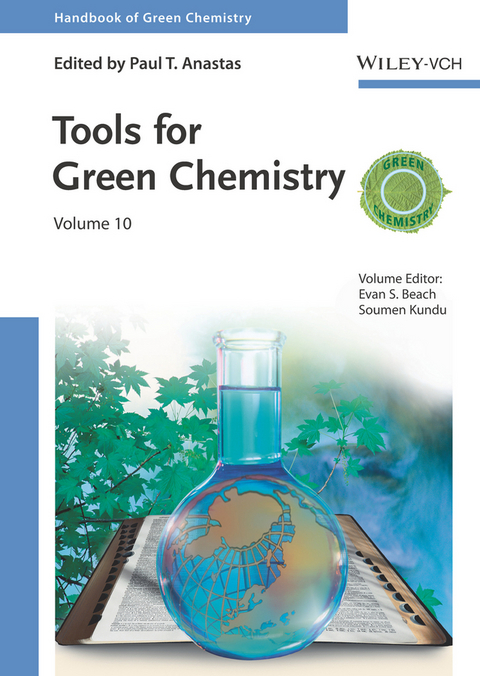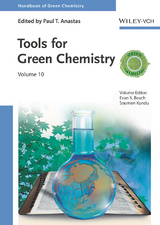Handbook of Green Chemistry - Tools for Green Chemistry
Wiley-VCH (Verlag)
978-3-527-32645-7 (ISBN)
Evan Beach received his PhD under the mentorship of Terry Collins at Carnegie Mellon University (2007) and was a Postdoctoral Associate at Yale University (2007-2009) in the research groups of Paul Anastas and Julie Zimmerman. He was an Associate Research Scientist (2009-2014) in the Center for Green Chemistry and Green Engineering at Yale, serving as Program Manager and contributing to the Center?s course offerings. He served on the editorial board of Green Chemistry Letters and Reviews from 2010-2014. Since 2015 he has been working as a research scientist in the chemical industry. Soumen Kundu obtained his Bachelor of Science and Master of Science degrees in chemistry at the University of Calcutta and the Indian Institute of Technology at Kanpur, respectively. He received his PhD in Inorganic Chemistry at Carnegie Mellon University in 2012 under the supervision of Professor Terrence J. Collins, during which he worked on the development and application of Fe-TAML (Tetra Amido Macrocyclic Ligand) catalysts for the remediation of organic pollutants in water. After completing his graduate studies, Dr. Kundu worked with Professor Chao-Jun Li at McGill University (2013-2015) as a postdoctoral fellow, where his research endeavors included methodology development and mechanistic understanding of ruthenium-catalyzed coupling reactions of carbonyls and alkynes to form olefins. In 2015, Dr. Kundu joined Phillips 66 as a research scientist, where his research is focused on heterogeneous catalyst development and application towards transportation fuel production. Paul T. Anastas joined Yale University as Professor and serves as the Director of the Center for Green Chemistry and Green Engineering at Yale. From 2004-2006, Paul Anastas has been the Director of the Green Chemistry Institute in Washington, D.C. Until June of 2004 he served as Assistant Director for Environment at e White House Office of Science and Technology Policy where his responsibilities included a wide range of environmental science issues including furthering international public-private cooperation in areas of Science for Sustainability such as Green Chemistry.
- Application of Life Cycle Assessment to Green Chemistry Objectives
- Finechem: Short-cut Models for Impact Assessment
- Models to Estimate Fate, Exposure, and Effects of Chemicals
- Collaborative Approaches to Advance Chemical Safety
- Introduction to Green Analytical Chemistry
- COSMO-RS Assisted Solvent Screening for Green Extraction of Natural Products
- Supramolecular Catalysis as a Tool for Green Chemistry
- Inverse Molecular Design Theory in Tight-Binding Frameworks and Its Applications
- Green Chemistry Molecular Recognition Processes for a Wide Variety of Metal Separations
- Shaping the Future of Additive Manufacturing: Twelve Themes from Bioinspired Design and Green Chemistry
- Rapid Screening of Reaction Pathway Alternatives
- The IFF Green Chemistry Assessment Tool
| Erscheint lt. Verlag | 7.6.2017 |
|---|---|
| Reihe/Serie | Handbook of Green Chemistry ; 12 |
| Mitarbeit |
Herausgeber (Serie): Paul T. Anastas |
| Verlagsort | Weinheim |
| Sprache | englisch |
| Maße | 170 x 240 mm |
| Gewicht | 736 g |
| Themenwelt | Naturwissenschaften ► Chemie |
| Technik ► Umwelttechnik / Biotechnologie | |
| Schlagworte | Biochemie • Chemie • Chemistry • Chemometrics & Data Handling • Chemometrics & Data Handling • Chemometrie u. Datenverarbeitung • Environmental Chemistry • Green chemistry • Industrial Chemistry • Industrielle Chemie • Nachhaltige u. Grüne Chemie • Nachhaltigkeit • Sustainable Chemistry & Green Chemistry • Sustainable Chemistry & Green Chemistry • Technische Chemie • Technische u. Industrielle Chemie • Umweltchemie • Umweltfreundliche Technologie |
| ISBN-10 | 3-527-32645-6 / 3527326456 |
| ISBN-13 | 978-3-527-32645-7 / 9783527326457 |
| Zustand | Neuware |
| Haben Sie eine Frage zum Produkt? |
aus dem Bereich




